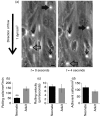Expression and function of endothelial selectins during human development
- PMID: 24831412
- PMCID: PMC4212954
- DOI: 10.1111/imm.12318
Expression and function of endothelial selectins during human development
Abstract
Leucocyte trafficking is vital for the immune defence. In adults, early tethering and rolling interactions between leucocytes and endothelial cells are mediated by P-, E- and L-selectins and their ligands. In contrast, the role of selectins in migration of mononuclear cells during fetal development in humans remains unknown. We studied the functions of endothelial E- and P-selectins and their counter-receptors during human ontogeny. Immunohistochemical stainings showed that P-selectin is expressed in megakaryocytes and endothelial cells starting from gestational weeks 7 and 11, respectively. Endothelial E-selectin appeared latest, at week 32. Real-time imaging using in vitro flow chamber assays showed that cord blood mononuclear leucocytes used E-, P- and L-selectin and PSGL-1 to roll on and adhere to endothelium under physiological shear stress. These data show that selectins are synthesized and functional before birth in humans and have the potential to mediate the emigration of mononuclear cells and inflammatory responses.
Keywords: adhesion molecules; cell recruitment/emigration; endothelium; ontogeny; selectins.
© 2014 John Wiley & Sons Ltd.
Figures




Similar articles
-
Threshold levels of fluid shear promote leukocyte adhesion through selectins (CD62L,P,E).J Cell Biol. 1997 Feb 10;136(3):717-27. doi: 10.1083/jcb.136.3.717. J Cell Biol. 1997. PMID: 9024700 Free PMC article.
-
No detectable endothelial- or leukocyte-derived L-selectin ligand activity on the endothelium in inflamed cremaster muscle venules.J Leukoc Biol. 2008 Jul;84(1):93-103. doi: 10.1189/jlb.1107786. Epub 2008 Apr 1. J Leukoc Biol. 2008. PMID: 18381812
-
Spatiotemporal expression dynamics of selectins govern the sequential extravasation of neutrophils and monocytes in the acute inflammatory response.Arterioscler Thromb Vasc Biol. 2015 Apr;35(4):899-910. doi: 10.1161/ATVBAHA.114.305143. Epub 2015 Feb 26. Arterioscler Thromb Vasc Biol. 2015. PMID: 25722429
-
Leukocyte ligands for endothelial selectins: specialized glycoconjugates that mediate rolling and signaling under flow.Blood. 2011 Dec 22;118(26):6743-51. doi: 10.1182/blood-2011-07-343566. Epub 2011 Oct 20. Blood. 2011. PMID: 22021370 Free PMC article. Review.
-
Carbohydrate ligands for the leukocyte-endothelium adhesion molecules, selectins.Results Probl Cell Differ. 2001;33:201-23. doi: 10.1007/978-3-540-46410-5_11. Results Probl Cell Differ. 2001. PMID: 11190676 Review. No abstract available.
Cited by
-
Neonatal Sepsis and Hemostasis.Diagnostics (Basel). 2022 Jan 20;12(2):261. doi: 10.3390/diagnostics12020261. Diagnostics (Basel). 2022. PMID: 35204352 Free PMC article. Review.
-
Receptor-Ligand Binding: Effect of Mechanical Factors.Int J Mol Sci. 2023 May 21;24(10):9062. doi: 10.3390/ijms24109062. Int J Mol Sci. 2023. PMID: 37240408 Free PMC article. Review.
-
The Role of Epithelial-to-Mesenchymal Transition Transcription Factors (EMT-TFs) in Acute Myeloid Leukemia Progression.Biomedicines. 2024 Aug 21;12(8):1915. doi: 10.3390/biomedicines12081915. Biomedicines. 2024. PMID: 39200378 Free PMC article. Review.
-
Proinflammatory Endothelial Phenotype in Very Preterm Infants: A Pilot Study.Biomedicines. 2022 May 20;10(5):1185. doi: 10.3390/biomedicines10051185. Biomedicines. 2022. PMID: 35625922 Free PMC article.
-
Therapeutics for sickle cell disease intravascular hemolysis.Front Physiol. 2024 Sep 13;15:1474569. doi: 10.3389/fphys.2024.1474569. eCollection 2024. Front Physiol. 2024. PMID: 39345787 Free PMC article. Review.
References
-
- Masopust D, Schenkel JM. The integration of T cell migration, differentiation and function. Nat Rev Immunol. 2013;13:309–20. - PubMed
-
- Ley K, Laudanna C, Cybulsky MI, Nourshargh S. Getting to the site of inflammation: the leukocyte adhesion cascade updated. Nat Rev Immunol. 2007;7:678–89. - PubMed
-
- Vachino G, Chang X-J, Veldman GM, Kumar R, Sako D, Fouser LA, Berndt MC, Cumming DA. P-selectin glycoprotein ligand-1 is the major counter-receptor for P-selectin on stimulated T cells and is widely distributed in non-functional form on many lymphocytic cells. J Biol Chem. 1995;270:21966–74. - PubMed
-
- Salmi M, Alanen K, Grenman S, Briskin M, Butcher EC, Jalkanen S. Immune cell trafficking in uterus and early life is dominated by the mucosal addressin madcam-1 in humans. Gastroenterology. 2001;121:853–64. - PubMed
Publication types
MeSH terms
Substances
LinkOut - more resources
Full Text Sources
Other Literature Sources

